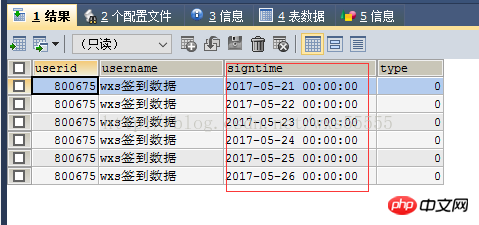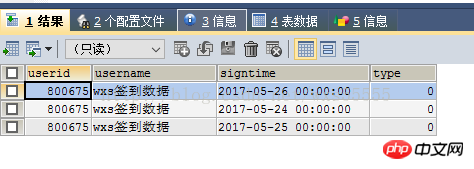
Cet article présente principalement l'implémentation MYSQL de la fonction de connexion continue. Il est très bon et a une valeur de référence. Les amis qui en ont besoin peuvent s'y référer.
1, créer une table de test
CREATE TABLE `testsign` ( `userid` int(5) DEFAULT NULL, `username` varchar(20) DEFAULT NULL, `signtime` timestamp NOT NULL DEFAULT CURRENT_TIMESTAMP ON UPDATE CURRENT_TIMESTAMP, `type` int(1) DEFAULT '0' COMMENT '为0表示签到数据,1表示签到日期字典数据' ) ENGINE=InnoDB DEFAULT CHARSET=utf8
2, insérer les données de test, l'heure d'enregistrement est 5.21 Sur 6.5, je peux écrire, mais je suis paresseux quand il s'agit d'écrire des procédures stockées. L'accent devrait être mis sur le code pour obtenir les données de connexion, qui est le troisième point, haha
<. 🎜>insert into `testsign` (`userid`, `username`, `signtime`, `type`) values('72164','字典','2017-05-21 00:00:00','1'); insert into `testsign` (`userid`, `username`, `signtime`, `type`) values('72164','字典','2017-05-22 00:00:00','1'); insert into `testsign` (`userid`, `username`, `signtime`, `type`) values('72164','字典','2017-05-23 00:00:00','1'); insert into `testsign` (`userid`, `username`, `signtime`, `type`) values('72164','字典','2017-05-24 00:00:00','1'); insert into `testsign` (`userid`, `username`, `signtime`, `type`) values('72164','字典','2017-05-25 00:00:00','1'); insert into `testsign` (`userid`, `username`, `signtime`, `type`) values('72164','字典','2017-05-26 00:00:00','1'); insert into `testsign` (`userid`, `username`, `signtime`, `type`) values('72164','字典','2017-05-27 00:00:00','1'); insert into `testsign` (`userid`, `username`, `signtime`, `type`) values('72164','字典','2017-05-28 00:00:00','1'); insert into `testsign` (`userid`, `username`, `signtime`, `type`) values('72164','字典','2017-05-29 00:00:00','1'); insert into `testsign` (`userid`, `username`, `signtime`, `type`) values('72164','字典','2017-05-30 00:00:00','1'); insert into `testsign` (`userid`, `username`, `signtime`, `type`) values('72164','字典','2017-05-31 00:00:00','1'); insert into `testsign` (`userid`, `username`, `signtime`, `type`) values('72164','字典','2017-06-01 00:00:00','1'); insert into `testsign` (`userid`, `username`, `signtime`, `type`) values('72164','字典','2017-06-02 00:00:00','1'); insert into `testsign` (`userid`, `username`, `signtime`, `type`) values('72164','字典','2017-06-03 00:00:00','1'); insert into `testsign` (`userid`, `username`, `signtime`, `type`) values('72164','字典','2017-06-04 00:00:00','1'); insert into `testsign` (`userid`, `username`, `signtime`, `type`) values('72164','字典','2017-06-05 00:00:00','1'); insert into `testsign` (`userid`, `username`, `signtime`, `type`) values('800675','吴小双签到数据','2017-05-21 00:00:00','0'); insert into `testsign` (`userid`, `username`, `signtime`, `type`) values('800675','吴小双签到数据','2017-05-22 00:00:00','0'); insert into `testsign` (`userid`, `username`, `signtime`, `type`) values('800675','吴小双签到数据','2017-05-23 00:00:00','0'); insert into `testsign` (`userid`, `username`, `signtime`, `type`) values('800675','吴小双签到数据','2017-05-24 00:00:00','0'); insert into `testsign` (`userid`, `username`, `signtime`, `type`) values('800675','吴小双签到数据','2017-05-25 00:00:00','0'); insert into `testsign` (`userid`, `username`, `signtime`, `type`) values('800675','吴小双签到数据','2017-05-26 00:00:00','0');
3. Interroger les données d'enregistrement continu
SELECT * FROM testsign WHERE TYPE=0 AND
DATE_FORMAT(signtime,'%Y%m%d')>(
SELECT IFNULL(MAX(DATE_FORMAT(signtime,'%Y%m%d')),"20170520") FROM testsign WHERE TYPE=1
AND DATE_FORMAT(signtime,'%Y%m%d')<=DATE_ADD(NOW(), INTERVAL -1 DAY)
AND DATE_FORMAT(signtime,'%Y%m%d') NOT IN (
SELECT DATE_FORMAT(signtime,'%Y%m%d') FROM testsign WHERE TYPE=0 AND userid=800675
)
)
AND DATE_FORMAT(signtime,'%Y%m%d')<='20170605'
AND userid=800675

8 articles recommandés sur la connexion continue
Petit boîtier de connexion continue ThinkPHP
Comment MySQL compte-t-il et interroge-t-il les enregistrements continus et les enregistrements cumulés
Ce qui précède est le contenu détaillé de. pour plus d'informations, suivez d'autres articles connexes sur le site Web de PHP en chinois!
 mysql modifier le nom de la table de données
mysql modifier le nom de la table de données
 MySQL crée une procédure stockée
MySQL crée une procédure stockée
 La différence entre MongoDB et MySQL
La différence entre MongoDB et MySQL
 Comment vérifier si le mot de passe MySQL est oublié
Comment vérifier si le mot de passe MySQL est oublié
 mysql créer une base de données
mysql créer une base de données
 niveau d'isolement des transactions par défaut de MySQL
niveau d'isolement des transactions par défaut de MySQL
 La différence entre sqlserver et mysql
La différence entre sqlserver et mysql
 mysqlmot de passe oublié
mysqlmot de passe oublié